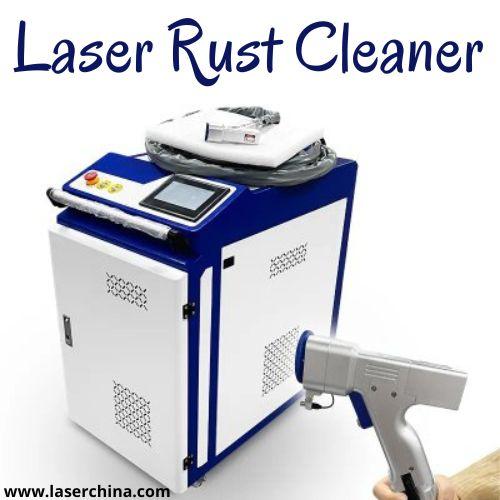Can a laser rust cleaner truly replace traditional rust removal methods in modern industries?

When industries face the challenge of dealing with rust, the search for efficient, safe, and long-lasting solutions never stops. For decades, methods such as sandblasting, chemical cleaning, and mechanical grinding have been the go-to approaches. However, the arrival of a laser rust cleaner has raised a serious question—can this technology truly stand as a replacement for conventional methods? To understand this, one needs to dive into how the system works, where it fits into today’s industrial landscape, and why businesses are now making the shift.
Understanding the Concept of a Laser Rust Cleaner
A laser rust cleaner operates using highly focused laser beams that interact with the rusted surface. Instead of physically scraping off rust or using corrosive chemicals, the laser targets only the unwanted layer. The energy from the beam breaks the bond between the rust and the metal underneath, vaporizing or lifting the rust particles in a controlled process.
This process is non-contact, which means no physical tool touches the surface, reducing the risk of surface damage. The underlying material remains intact while the rust disappears layer by layer. For industries dealing with expensive machinery, historic restoration, or sensitive metal surfaces, this precision becomes a game-changer.
Why Industries Are Paying Attention to Laser Rust Cleaners
Every industrial sector seeks two things: operational efficiency and cost reduction. Rust is not just a cosmetic issue; it can weaken structures, compromise machinery, and reduce the lifespan of assets. When rust isn’t managed properly, businesses lose valuable time in repairs and replacements.
A laser rust cleaner provides a systematic approach by ensuring uniform cleaning without the mess of abrasive materials or toxic byproducts. It also simplifies the process because operators can direct the beam with precision on specific areas rather than treating the entire surface.
For industries like shipbuilding, aviation, automotive manufacturing, and construction, even a small miscalculation in surface treatment can cost heavily in terms of safety and compliance. This is why more companies are investigating whether a laser rust cleaner can become their primary solution.
Comparing with Traditional Rust Removal
Traditional methods rely heavily on physical force or chemical reaction. Grinding, for example, removes rust but also shaves off some of the base material. Sandblasting is effective for large-scale projects but creates dust clouds, requiring protective measures and extensive cleanup. Chemical cleaning dissolves rust but brings in environmental and safety concerns, especially when handling toxic waste.
The laser rust cleaner, on the other hand, delivers targeted action without the same drawbacks. It does not create piles of waste material and does not expose workers to harmful substances. Industries dealing with high regulatory standards, such as aerospace or energy, are particularly drawn to this feature because compliance is easier when waste is minimized.
Industrial Applications of a Laser Rust Cleaner
The potential applications of a laser rust cleaner extend across industries.
-
Automotive Sector: Car manufacturers and restorers use it to treat rusted body parts without compromising thin metal sheets. Classic car restoration especially benefits from precision cleaning, where even a minor dent or excessive grinding can destroy authenticity.
-
Aerospace Industry: Aircraft components require rust removal without altering the physical properties of the metal. The non-contact cleaning process ensures that sensitive parts remain unaffected.
-
Shipbuilding and Marine Equipment: Constant exposure to moisture makes rust removal an ongoing task in shipyards. Laser rust cleaning offers a sustainable way to manage corrosion on large vessels without generating environmental hazards.
-
Construction and Heavy Machinery: Equipment exposed to outdoor conditions faces continuous corrosion. With laser cleaning, machinery parts regain functionality faster, reducing downtime.
-
Cultural Heritage and Restoration: Historical metal artifacts often require delicate cleaning. A laser rust cleaner can target corrosion without damaging the centuries-old underlying metal.
Cost Implications and Long-Term Benefits
Investing in a laser rust cleaner may seem costly at first glance, but the long-term value changes the equation. Traditional methods require constant purchasing of consumables such as abrasive materials, chemicals, and protective gear. Additionally, labor costs rise due to cleanup and safety measures.
Laser rust cleaning, however, primarily requires electricity to power the system and occasional maintenance. Since the machine doesn’t consume sand, chemicals, or other materials, operational costs reduce significantly over time. For businesses handling frequent rust treatment, this becomes a cost-saving strategy in the long run.
Safety and Workplace Impact
Workplace safety is another area where a laser rust cleaner stands out. With no chemicals or abrasive dust clouds, operators work in a safer environment. Modern systems are designed with built-in safety protocols, including enclosures, ventilation, and automated settings.
Workers spend less time dealing with hazardous waste disposal, and training becomes easier since operating a laser system is largely about precision control rather than heavy physical labor. This also means industries can reallocate labor resources more effectively.
Environmental Considerations
Industries worldwide face growing pressure to adopt eco-friendly practices. Chemical cleaning methods generate toxic waste that needs safe disposal, and abrasive blasting releases micro-particles into the environment. A laser rust cleaner eliminates these concerns by using light energy to remove rust.
The process generates only minimal residue in the form of fine dust, which is easier to contain and dispose of. For companies with strict sustainability goals, this technology aligns with green initiatives without sacrificing efficiency.
Future of Rust Removal Technology
The industrial landscape is shifting toward automation, precision, and sustainability. A laser rust cleaner fits perfectly into this vision. As technology advances, these machines are becoming more portable, more powerful, and increasingly affordable.
Integration with robotics and AI-driven precision (such as robotic arms guiding the laser) is already being tested in some industries. This points to a future where rust removal is not only efficient but also highly automated, reducing downtime and human involvement in hazardous environments.
Final Thoughts
The question of whether a laser rust cleaner can replace traditional methods is becoming less about possibility and more about timing. The technology has already proven itself in terms of efficiency, precision, safety, and environmental responsibility. While some industries may continue using traditional approaches for cost or habit, the momentum is clearly shifting toward laser-based systems.
As industries modernize, the demand for solutions that save time, reduce costs, and support sustainability will keep growing. A laser rust cleaner isn’t just an alternative—it is rapidly becoming the standard for modern rust removal, shaping the future of industrial maintenance and preservation.
- Seo
- Art
- Causes
- Crafts
- Dance
- Drinks
- Film
- Fitness
- Food
- الألعاب
- Gardening
- Health
- الرئيسية
- Literature
- Music
- Networking
- أخرى
- Party
- Religion
- Shopping
- Sports
- Theater
- Wellness
- Business & Money

